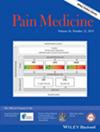Comparison of tibial nerve pulsed radiofrequency and intralesional radiofrequency thermocoagulation in the treatment of painful calcaneal spur and plantar fasciitis: A randomized clinical trial.
IF 2.9
3区 医学
Q1 ANESTHESIOLOGY
引用次数: 0
Abstract
OBJECTIVE Ultrasound-guided tibial nerve pulsed radiofrequency (US-TN PRF) and fluoroscopy-guided intralesional radiofrequency thermocoagulation (FL-RFT) adjacent to the painful calcaneal spur are two interventions for pain management in painful calcaneal spur (PCS) and plantar fasciitis (PF). This study aimed to compare the effectiveness of the two procedures. DESIGN A prospective, randomized, single-blind study. SETTING Single-center pain clinic. SUBJECTS Forty-nine patients who met the inclusion criteria were randomized into two groups. METHODS 25 patients (group U) received US-TN PRF at 42 °C for 240 s, while 24 patients (group F) received intralesional FL-RFT at 80 °C for 90 s. The most severe Numeric Rating Scale (NRS) score during the first morning steps and the American Orthopedic Foot and Ankle Society (AOFAS) ankle hindfoot scores were used to evaluate the effectiveness of the procedures. The study's primary outcome assessed treatment effectiveness using the NRS, whereas the secondary outcomes included changes in the AOFAS score and the incidence of procedure-related mild adverse events. RESULTS NRS and AOFAS scores significantly improved in groups U and F at 1 and 3 months compared to baseline (p < 0.05), and there was no significant difference between the groups. At month 1, 50% or greater pain relief was achieved in 72% of patients in group U and 75% in group F. No significant difference was observed in the incidence of mild adverse events between the groups. CONCLUSIONS US-TN PRF and intralesional FL-RFT have shown significant effectiveness in the treatment of PCS and PF. Larger randomized controlled trials are needed.胫神经脉冲射频与椎管内射频热凝在治疗疼痛性方骨骨刺和足底筋膜炎中的比较:随机临床试验。
目的超声引导下的胫神经脉冲射频(US-TN PRF)和透视引导下的疼痛方骨刺邻近区域内射频热凝(FL-RFT)是治疗疼痛性方骨刺(PCS)和足底筋膜炎(PF)的两种疼痛干预方法。本研究旨在比较这两种治疗方法的有效性。设计前瞻性、随机、单盲研究。晨起第一步时最严重的数字评定量表(NRS)评分和美国足踝矫形协会(AOFAS)踝关节后足评分用于评估治疗效果。研究的主要结果是使用 NRS 评估治疗效果,次要结果包括 AOFAS 评分的变化和与手术相关的轻度不良事件的发生率。结果与基线相比,U 组和 F 组在 1 个月和 3 个月时的 NRS 和 AOFAS 评分明显提高(P < 0.05),组间无明显差异。在第 1 个月,72% 的 U 组患者和 75% 的 F 组患者的疼痛缓解率达到或超过 50%。在轻度不良反应的发生率方面,两组之间无明显差异。需要进行更大规模的随机对照试验。
本文章由计算机程序翻译,如有差异,请以英文原文为准。
求助全文
约1分钟内获得全文
求助全文
来源期刊

Pain Medicine
医学-医学:内科
CiteScore
6.50
自引率
3.20%
发文量
187
审稿时长
3 months
期刊介绍:
Pain Medicine is a multi-disciplinary journal dedicated to pain clinicians, educators and researchers with an interest in pain from various medical specialties such as pain medicine, anaesthesiology, family practice, internal medicine, neurology, neurological surgery, orthopaedic spine surgery, psychiatry, and rehabilitation medicine as well as related health disciplines such as psychology, neuroscience, nursing, nurse practitioner, physical therapy, and integrative health.
 求助内容:
求助内容: 应助结果提醒方式:
应助结果提醒方式:


